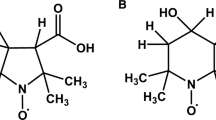Abstract
The dipole-dipole interaction between polarized β active probes implanted into a metal and the surrounding host nuclei may lead to a transfer of polarization from the probe to the host. As energy must be conserved in this cross-relaxation (CR) process, resonance-like dips show up at certainB values, if the polarization of the probes is measured as a function of magnetic inductionB.
The probe isotope12B has been studied in several metallic stoppers. For12B in the fec crystals Al, Cu the three possible cubic implantation sites could easily be discriminated by means of the CR technique. The temperature dependence of the dips yielded information on the diffusion of the probes. In the case of12B, in Cu above 400 K a further CR structure was found due to trapping of the probe at another site. In the bcc metal VCR spectra belonging to two different12B trapping sites could be separately registered using a special radiofrequency technique. Both, static and dynamical properties of the CR could be quantitatively explained by theory.
Similar content being viewed by others
References
P.M.G. Bavin, D. Stephenson and J.A.S. Smith, Z. Naturforsch 41a (1986) 195.
R.F. Kiefl, Muon level-crossing resonance in magnetically ordered materials this conference.
A. Abragam,The Principles of Nuclear Magnetism (Oxford, Clarendon Press, 1961).
F. Fujara, H.-J. Stöckmann, H. Ackermann, W. Buttler, K. Dörr, H. Grupp, P. Heitjans, G. Kiese and A. Körblein, Z. Phys. B 37 (1980) 151.
E. Jäger, B. Ittermann, H.-J. Stöckmann, K. Bürkmann, B. Fischer, H.-P. Frank, G. Sulzer, H. Ackermann and P. Heitjans, Phys. Lett. 123 A (1987) 39.
H. Ackermann, P. Heitjans and H.-J. Stöckmann, in:Hyperfine Interactions of Radioactive Nuclei, ed. J. Christiansen, Topics in Current Physics 31 (Springer Verlag, Berlin, Heidelberg, New York, Tokyo, 1983) p. 291.
R.F. Kiefl, Hyp. Int. 32 (1986) 707.
S. Dattagupta,Relaxation Phenomena in Condensed Matter Physics (Academic Press, London, 1987).
H.-J. Stöckmann, J. Phys. C, in print.
T.K. McNab and R.E. McDonald, Phys. Rev. B 13 (1976) 34.
T.K. McNab, J.D. Perez and R.E. McDonald, Phys. Rev. B 18 (1978) 92.
E. Jäger, Thesis, Marburg, 1987.
G.H. Fuller, J. Phys. Chem. Ref. Data 5 (1976) 835.
R.E. McDonald and T.K. McNab, Phys. Lett. 63 A (1977) 177.
T. Minamisono, Y. Nojiri, K. Ise and K. Asahi, Hyp. Int. 15/16 (1983) 547.
Author information
Authors and Affiliations
Rights and permissions
About this article
Cite this article
Stöckmann, H.J., Jäger, E., Sulzer, G. et al. Cross relaxation studied by β NMR. Hyperfine Interact 49, 235–252 (1989). https://doi.org/10.1007/BF02405144
Issue Date:
DOI: https://doi.org/10.1007/BF02405144




